
7
Chimney connection
A 6” diameter single wall stove pipe, used to connect the
stove to the chimney, must be installed with the crimped
end toward the stove. This will ensure that the moisture
which condenses from the burning wood will flow back into
the fire chamber. Each joint in the stove pipe must be
secured with at least three sheet metal screws.
This room heater must be connected to:
1)
A chimney complying with the requirements for Type HT
chimneys in the Standard for Chimneys, Factory-Built,
Residential Type and Building Heating Appliance UL 103,
or
2)
A code-approved masonry chimney with a flue liner.
Vent the stove into a masonry chimney or an approved,
insulated solid-fuel stainless-steel chimney with as short
and straight a length of six-inch (150mm) diameter smoke
pipe as possible. Connection to a masonry chimney must
be by a metal or masonry thimble cemented in place. An
insulated stainless steel chimney must be supported at the
ceiling or roof and its installation must comply with its
manufacturer’s instructions.
THE TOTAL HORIZONTAL VENT LENGTH SHOULD
NOT EXCEED 40% OF THE CHIMNEY HEIGHT ABOVE
THE STOVE.
All horizontal smoke pipe must slope slightly
upwards a minimum of 1/4" per foot (6mm/0.3m) and
all connections must be tight and secured by three
sheet metal screws equally spaced.
An uninsulated smoke pipe shall not pass through an
attic, roof space, closet or similar concealed space,
or through a floor, ceiling, wall or partition, or any
combustible construction.
DO NOT USE ANY MAKESHIFT MATERIALS DURING
INSTALLATION.
1.
Move the stove into position with the flue centered,
midpoint between two joists to prevent having to cut them.
Use a plumb bob to line up the centre.
2.
Cut and frame an opening in the roof to provide a 2"
clearance between the outside of the chimney and any
combustible material.
DO NOT FILL THIS SPACE WITH ANY TYPE OF
MATERIAL.
Nail headers between the joist for extra support.
Firestop spacers must be placed on the bottom of each
framed opening in any floor or ceiling that the chimney
passes through.
3.
Hold a plumb bob from the underside of the roof to
determine where the opening in the roof should be. Cut
and frame the roof opening to maintain proper 2"
clearances.
Adding chimney sections
Add chimney sections, according to
m a n u f a c t u r e r ’s
i n s ta l l a t i o n
instructions, to the required height.
The chimney must extend, atleast, 3
feet above its point of contact with the
roof and atleast 2 feet higher than any
wall, roof or building within 10 feet. If
your chimney system is enclosed
within the attic area, a rafter radiation
shield is required.
Outside air
If possible connect the air intake at the bottom to the
outside with a 4 inch (100mm) diameter fresh air kit
available at your Napoleon/Wolf Steel Ltd. dealer. Follow
detailed instructions under “Mobile Home Outside Air".
Flue collar reversal
The flue collar is oriented
in the Top Exit position.
Remove
the
two
mounting bolts, and turn
the collar 180 degrees.
Secure the collar using
the same bolts, nuts and
washers.
Ash fender installation
To avoid damage during
transport, the ash fender
has been stored behind the
main door. Pivot the ash
fender onto tab “A” and
lower into place.
Wall pass-through
If possible, design the installation so that the connector
does not pass through a combustible wall. If during your
installation you must pass through a combustible wall,
check with your building
inspector before you
begin. Also check with the
chimney
connector
manufacturer for any
specific requirements.
Consult with your dealer
regarding
special
connection components
available for use for wall
pass-throughs.
Use only parts that have been tested and listed for use in a
wall pass-through.
Heat shield installation
The heat shield stored in the unit must be installed under
the stove with 2 provided screws. Please, see page 8 to
respect the orientation of the heat shield.
2 F T .
M I N
.
1 0 F T .
3 F T .
M I N
.
A
This is the preferred
method of passing a flue
pipe through a combustible
wall to a masonry chimney








































